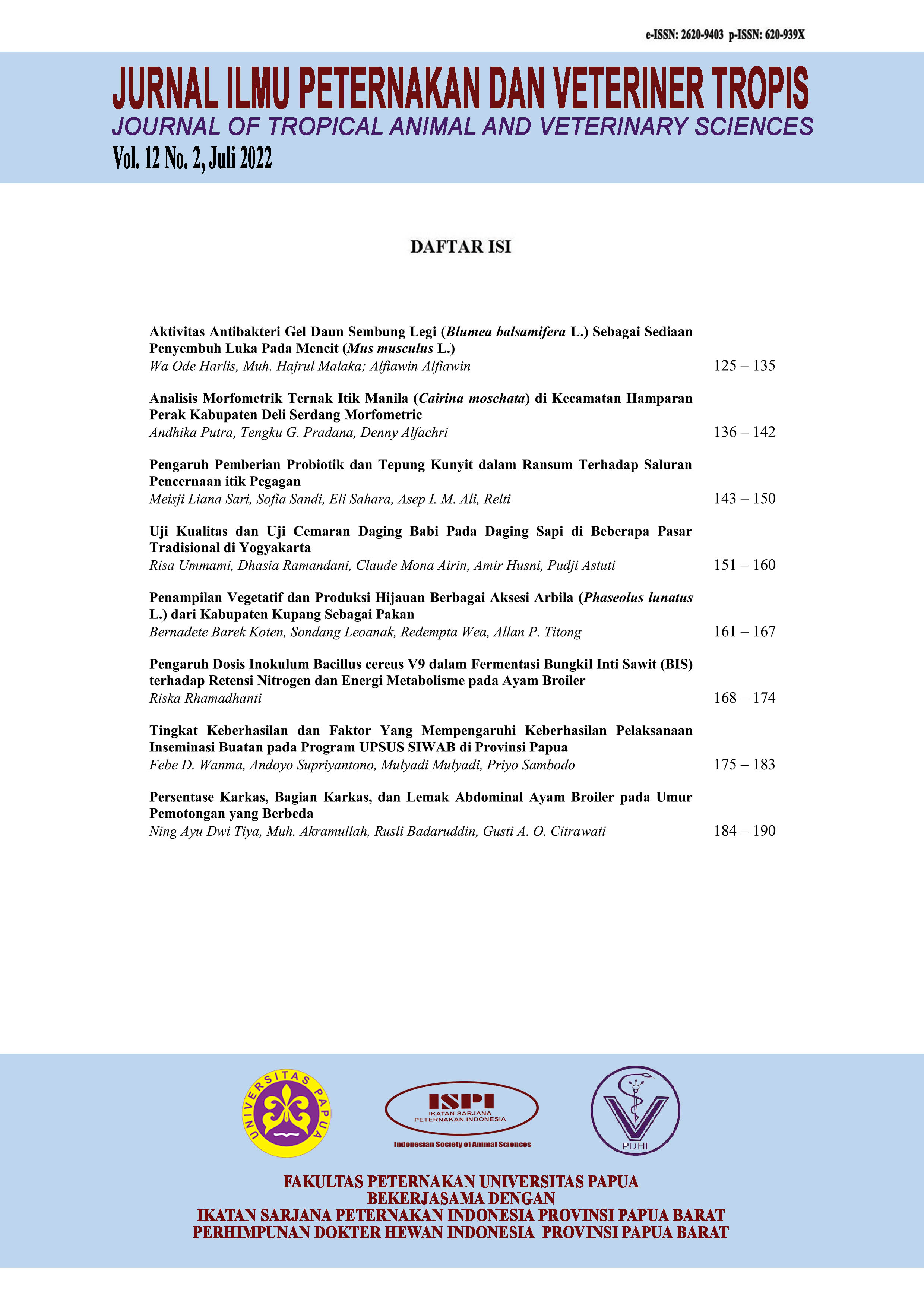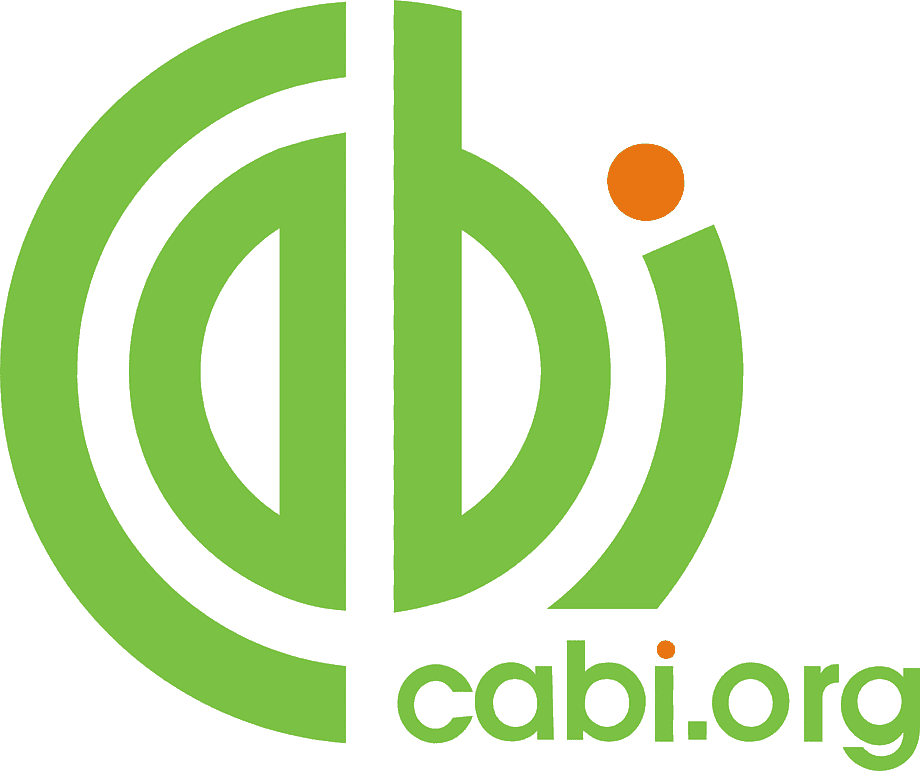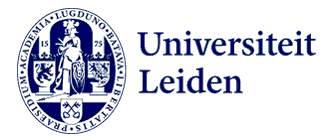Analisis Morfometrik Ternak Itik Manila (Cairina moschata) di Kecamatan Hamparan Perak Kabupaten Deli Serdang
Morfometric Analysis of Muscovy Duck (Cairina Moschata) at District of Hamparan Perak, Deli Serdang District
DOI:
https://doi.org/10.46549/jipvet.v12i2.215Keywords:
Keywords: Muscovy Duck, MorphometricAbstract
Abstract
Muscovy ducks are included in the genus Cairina (Cairina moschata) originating from Mexico, Central America and South America. In Indonesia, this type of duck is known as a duck (entok) or Muscovy duck (muscovy duck). The Muscovy duck belongs to poultry that has relatively shorter legs than its body; the fingers have swimming membranes; the beak is covered by a delicate, sensitive membrane; concave-shaped fur, thick and greasy. The Muscovy duck is a waterfowl that leads to meat as potential commodity that has to be cultivated. This study aims to determine the phenotypic diversity of the Muscovy duck based on morphometrics. The method used in this study was purposive random sampling with the provision that Muscovy ducks aged over 6 months with a total of 100 male and 100 female Muscovy ducks. The parameter measured in this study were beak length, neck length, body length, wing bone length, body weight, femur length, shank length and third finger bone length. The results indicate that the head includes the beak length of males 5.65 ± 0.35 cm and females 4.81 ± 0.31 cm. Male neck length 17.68±0.98 cm, and female 9.01±0.62 cm. Body parts include male body length of 25.86±0.86 cm, and female body length of 23.22±1.02 cm. The length of the wing bones of males is 27.50±1.24 cm, and that of females is 21.76±1.05 cm. Male body weight 3.45±0.20 kg, and female 1.99±0.28 kg. The legs include the length of the male thigh 8.72±0.44 cm, and the female 8.59±0.35 cm. male tarsometatarsus shank length 4.56±0.43 cm, and female 3.83±0.32 cm. The length of the third finger is 7.8±0.26 cm, and the female is 6.40±0.65 cm. The results showed that the morphometric size of the male Muscovy duck was longer than that of the female Muscovy duck due to its phylogenetic characteristics.
Keywords: Muscovy Duck, Morphometric
Abstrak
Itik Muscovy termasuk dalam keluarga (genus) Cairina (Cairina moschata) berasal dari Meksiko, Amerika Tengah dan Amerika Selatan. Di Indonesia bebek ini dikenal dengan mentok (entok) atau itik Muscovy (muscovy duck) dan cukup berpotensi untuk dibudidayakan. Penelitian ini bertujuan untuk mengetahui keragaman fenotipik itik Muscovy berdasarkan morfometrik. Metode yang digunakan dalam penelitian ini adalah purposive random sampling dengan ketentuan itik Muscovy berusia diatas 6 bulan dengan jumlah data 100 ekor jantan dan 100 ekor betina itik Muscovy. Data yang diukur adalah panjang paruh, panjang leher, panjang badan, panjang tulang sayap, bobot badan, panjang tulang paha, panjang shank dan panjang tulang jari ketiga. Panjang paruh jantan 5,65±0,35 cm dan betina 4,81±0,31 cm. Panjang leher jantan 17,68±0,98 cm, dan betina 9,01±0,62 cm. Panjang badan jantan 25,86±0,86 cm, dan betina 23,22±1,02 cm. Panjang tulang sayap jantan 27,50±1,24 cm, dan betina 21,76±1,05 cm. Bobot badan jantan 3,45±0,20 kg, dan betina 1,99±0,28 kg. Panjang paha jantan 8,72±0,44 cm, dan betina 8,59±0,35 cm. Panjang shank tarsometatarsus jantan 4,56±0,43 cm, dan betina 3,83±0,32 cm. Panjang jari ketiga 7,8±0,26 cm, dan betina 6,40±0,65 cm. Kesimpulan: Ukuran morfometrik itik Muscovy jantan lebih panjang dari pada itik Muscovy betina karena sifat phylogenetik.
Kata Kunci : Itik Muscovy, Morfometrik
Downloads
References
Balai Pengkajian Teknologi Pertanian (2010). Petunjuk Teknis Budidaya Ternak Itik. Balai Besar Pengkajian Dan Pengembangan Teknologi Pertanian Badan Penelitian Dan Pengembangan Pertaniankementerian Pertanian Jawa barat. Hal 6. (Buku)
Brahmantiyo, B., L. H. Prasetyo, A.R. Setioko, dan R. H. Mulyono. 2003. Pendugaan jarak genetik dan faktor peubah pembeda galur Itik (Alabio, Bali, Khaki Campbell, Mojosari dan Pegagan) melalui Analisis Morfometrik. Jurnal Ilmu Ternak dan Veteriner hal 1-7 (Jurnal)
Fatmarischa et al (2013) Fatmarischa, Sutopo dan S. Johari. 2013. Ukuran Tubuh Entok di Tiga Kabupaten Provinsi Jawa Tengah. Jurnal Sains Peternakan, 11 (2) : 106-112. (Jurnal)
Fayeye et al. (2006). Fayeye TR, Ayorinde KL, Ojo V, Adesina OM.2006. Frequency and influence of some major genes on body weight and size parameters of nigerian lokal chicken. Livestock Res Rural Dev 18: 1-8. (Jurnal)
Johari, S., Sutopo, dan A. Santi. 2009. Frekuensi fenotipik sifat-sifat kualitatif Ayam Kedu dewasa. Seminar Nasional Kebangkitan Peternakan. Semarang, 20 Mei 2009. Hal 606-616 (Prosiding)
Kusuma dan Prijono (2007) Kusuma, D. dan N. S. Prijono. 2007. Keanekaragaman Sumber Daya Hayati Ayam Lokal Indonesia : Manfaat dan Potensi . LIPI Press. Jakarta. (Buku)
Ogah, D.M., O.M. Momoh, and N.I. Dim. 2011. Application Of Canonical Discriminant Analysis For Assessment Of Genetic Variation In Muscovy Duck Ecotypes In Nigeria. Egypt Poult Sci. Vol 13 (2) : p. 429 –436. (Jurnal)
Oguntunji & Ayorinde (2014) Oguntunji AO, Ayorinde KL. 2014. Sexual size dimorphism and sex determination by morphometric measurements in locally adapted Muscovy duck (Cairina moschata) in Nigeria. Acta Agric Slov. 104:15-24. (Buku)
Raji et al. (2009) Raji AO, Igwebuike JU, Usman MT. 2009. Zoometrical body measurements and their relation with live weight in matured local Muscovy ducks in Borno State, Nigeria. ARPN J Agric Biol Sci. 4:58-62.( Jurnal)
Soeparno (1998 Soeparno. 2005. Ilmu dan teknologi daging cetakan keempat. Gadjah Mada University Press, Yogyakarta. (Buku)
Sitanggang et al (2015) Sitanggang, E. N., Hasnudi, dan Hamdan. 2015. Kergaman sifat kualitatif dan morfometrik antara ayam kampung, ayam Bangkok, ayam katai, ayam birma, ayam bagon dan magon di Medan. Jurnal Peternakan Integratif. 3 (2) : 167- 189. (Jurnal)
Sri Anggraini (2020), Sri, Anggraini (2020) Keragaman Sifat Kuantitatif Ternak Entok (Cairina Moschata) Di Kecamatan Kuranji Kota Padang. Diploma thesis, Universitas Andalas. (Thesis)
Tamzil MH, Lestari, Indarsih B. 2018. Measurement of several qualitative traits and body size of Lombok Muscovy ducks (Cairina moshcata) in semi-intensive rearing. Indonesian Trop Anim Agric. 43. (Jurnal)
Veeramani et al., (2014) Veeramani, P., R. Prabakaran., S.T. Selvan., S.N. Sivaselvam, and T. Sivakumar. 2014. Morphology and Morphometry of Indigenous Ducks of Tamil Nadu. Global Journal of Medical Research: G Veterinary Science and Veterinary Medicine. Vol. 14 (3) : p. 16 –20. (Jurnal)
Yakubu, A. (2011). Discriminant analysis of sexual dimorphism inmorphological traits of african Muscovy ducks. Arch. Zootec 60 (232): 1115-1123. (Jurnal)
Downloads
Published
How to Cite
Issue
Section
License
Copyright (c) 2022 Andhika Putra, Tengku G. Pradana, Denny Alfachri

This work is licensed under a Creative Commons Attribution-NonCommercial-ShareAlike 4.0 International License.
License and Copyright Agreement
In submitting the manuscript to the journal, the authors certify that:
- They are authorized by their co-authors to enter into these arrangements.
- The work described has not been formally published before, except in the form of an abstract or as part of a published lecture, review, thesis, or overlay journal. Please also carefully read Jurnal Ilmu Peternakan dan Veteriner Tropis (Journal of Tropical Animal and Veterinary Science) Posting Your Article Policy at https://journal.fapetunipa.ac.id/index.php/JIPVET/publicationethics
- That it is not under consideration for publication elsewhere,
- That its publication has been approved by all the author(s) and by the responsible authorities “tacitly or explicitly“ of the institutes where the work has been carried out.
- They secure the right to reproduce any material that has already been published or copyrighted elsewhere.
- They agree to the following license and copyright agreement.
Copyright
Authors who publish with Jurnal Ilmu Peternakan dan Veteriner Tropis (Journal of Tropical Animal and Veterinary Science) agree to the following terms:
- Authors retain copyright and grant the journal right of first publication with the work simultaneously licensed under a Creative Commons Attribution License (CC BY-NC-SA 4.0) that allows others to share the work with an acknowledgment of the work's authorship and initial publication in this journal.
- Authors are able to enter into separate, additional contractual arrangements for the non-exclusive distribution of the journal's published version of the work (e.g., post it to an institutional repository or publish it in a book), with an acknowledgment of its initial publication in this journal.
- Authors are permitted and encouraged to post their work online (e.g., in institutional repositories or on their website) prior to and during the submission process, as it can lead to productive exchanges, as well as earlier and greater citation of published work.

This work is licensed under a Creative Commons Attribution-NonCommercial-ShareAlike 4.0 International License.





























.png)
